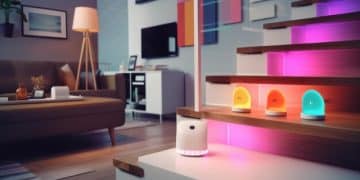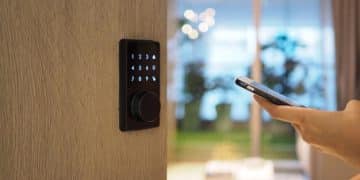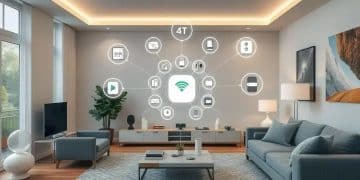Building a budget-friendly smart home on a dime
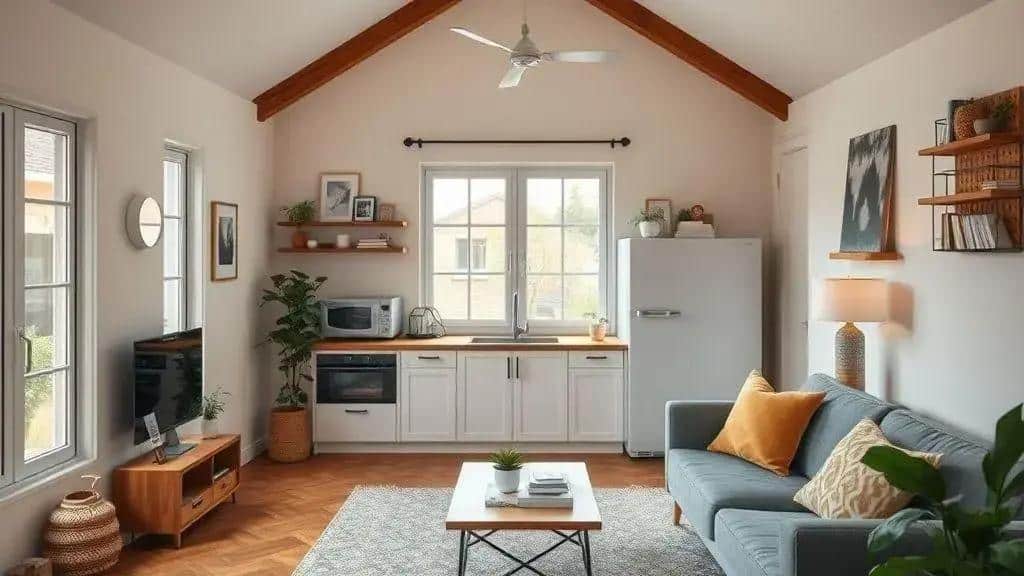
Building a budget-friendly smart home involves selecting affordable devices, automating routines, and integrating energy-efficient technology to enhance comfort and convenience without overspending.
Building a budget-friendly smart home might seem like a daunting task, but it can be an enjoyable journey. Have you ever wondered how easy it could be to integrate smart technologies into your space without breaking the bank? Let’s dive into some practical ways to elevate your home!
Understanding the basics of smart home technology
Understanding smart home technology can feel overwhelming, but it doesn’t have to be. With a few key concepts, you can easily grasp how to build a budget-friendly smart home. Let’s break it down and explore the fundamentals.
What is Smart Home Technology?
At its core, smart home technology allows you to control devices in your home remotely. This technology includes everything from lights and thermostats to security cameras and appliances. With a smartphone, you can manage these devices from anywhere.
Key Components of a Smart Home
- Smart Hub: The center of your smart home, connecting all devices.
- Smart Devices: Gadgets that can be controlled remotely, like bulbs and speakers.
- Wi-Fi Connection: Essential for communication between devices.
Each component plays a vital role in creating a seamless experience. A smart hub simplifies control, allowing you to manage multiple devices through one application. This setup can enhance your daily routines by making home management easier.
Integration is important. The more devices you connect, the smarter your home becomes. For instance, you can set your lights to turn on automatically when your smart lock is activated. This not only adds convenience but also increases security.
Types of Smart Devices
When it comes to building a budget-friendly smart home, knowing your options is crucial. Here are some types of devices you should consider:
- Smart Thermostats: These can learn your schedule and help save energy.
- Smart Lights: Control brightness and color to suit any mood.
- Smart Plugs: Turn any appliance into a smart device.
By selecting affordable options, you can gradually enhance your home without a significant investment. Take your time researching different products, reading reviews, and comparing prices.
Incorporating smart home technology can sound complex, but with the right information, you can become comfortable with it. Remember that starting small can lead to meaningful improvements in your home’s efficiency, safety, and comfort.
Affordable smart devices for every room

Finding affordable smart devices for every room in your home can make a world of difference. These devices enhance your living experience without draining your wallet. From smart bulbs to thermostats, let’s explore some great options you can easily integrate.
Smart Lighting Solutions
Smart lights are one of the simplest ways to get started. They offer control over brightness and color, creating the perfect mood. You can set schedules and control them remotely, adding convenience to your daily routine.
- Smart bulbs: Compatible with major hubs, providing excellent energy savings.
- LED strips: Ideal for ambiance, adding flexibility to your decor.
- Smart switches: Upgrade existing fixtures without replacing bulbs.
These options allow you to customize your lighting experience, enhancing comfort while saving on electricity costs.
Smart Thermostats
Another essential device is a smart thermostat, which plays a critical role in energy efficiency. These devices learn your schedule and adjust the temperature accordingly. This smart feature can help you save money on heating and cooling costs.
- Learning thermostats: Automatically adjust settings based on your habits.
- Wi-Fi enabled models: Control your home’s temperature from anywhere via an app.
- Energy reports: Receive insights on usage and savings.
These devices make achieving your comfort goals easier, significantly lowering your energy bills over time.
Security Devices
Keeping your home safe is crucial. Affordable smart security devices can provide peace of mind. Consider options like smart cameras and doorbells that allow you to monitor your home from your smartphone.
- Smart doorbells: See who’s at the door, even when you’re not home.
- Indoor/outdoor cameras: Keep an eye on your property with 24/7 monitoring.
- Smart locks: Grant access to trusted visitors easily.
With these devices, you’ll feel secure while keeping track of everything happening in and around your home.
Incorporating these affordable smart devices into your home is easier than you think. Each room can benefit from enhanced functionality, making your home smarter and more efficient.
Energy savings with smart home solutions
Energy savings with smart home solutions can drastically reduce your utility bills. By utilizing modern technology, you can not only enhance comfort in your home but also be eco-friendly. Let’s delve into how smart systems can help you save energy efficiently.
Automating Your Energy Use
One of the key benefits of smart home technology is automation. You can set devices to operate only when needed, which prevents energy waste. For example, smart thermostats can learn your routine, adjusting heating and cooling only when necessary.
- Schedule settings: Configure your smart thermostat to lower temperatures during the night.
- Remote control: Adjust settings from your smartphone when you’re away.
- Energy usage reports: Track your consumption to identify patterns.
This level of customization makes a big difference in energy efficiency and comfort.
Smart Lighting for Energy Efficiency
Lighting constitutes a large portion of energy usage in homes. By using smart lighting, you can significantly reduce electricity consumption. Smart bulbs can automatically turn off when no one is in a room and can be adjusted for brightness or color based on your preferences.
- Motion sensors: Lights turn on only when someone is present.
- Dimmer functionalities: Reduce brightness during the day to save energy.
- Voice control: Easily manage bulbs with smart speakers.
These features not only provide convenience but also encourage mindful energy consumption.
Integrating Smart Appliances
Investing in smart appliances is another way to save energy. Many modern devices are designed to be energy-efficient and can be scheduled to run during off-peak hours when electricity rates are lower. Look for appliances that have energy-saving certifications, as they often come with built-in smart technology.
- Smart refrigerators: Optimize cooling efficiency.
- Smart ovens: Can be preheated remotely, saving time and energy.
- Smart washers and dryers: Run cycles during off-peak hours for savings.
By incorporating these appliances into your home, you’ll find it easier to cut down on energy waste.
Utilizing smart home solutions for energy savings can transform how you consume energy. These technologies put you in control of your usage while providing comfort and convenience.
DIY tips for a smart home setup
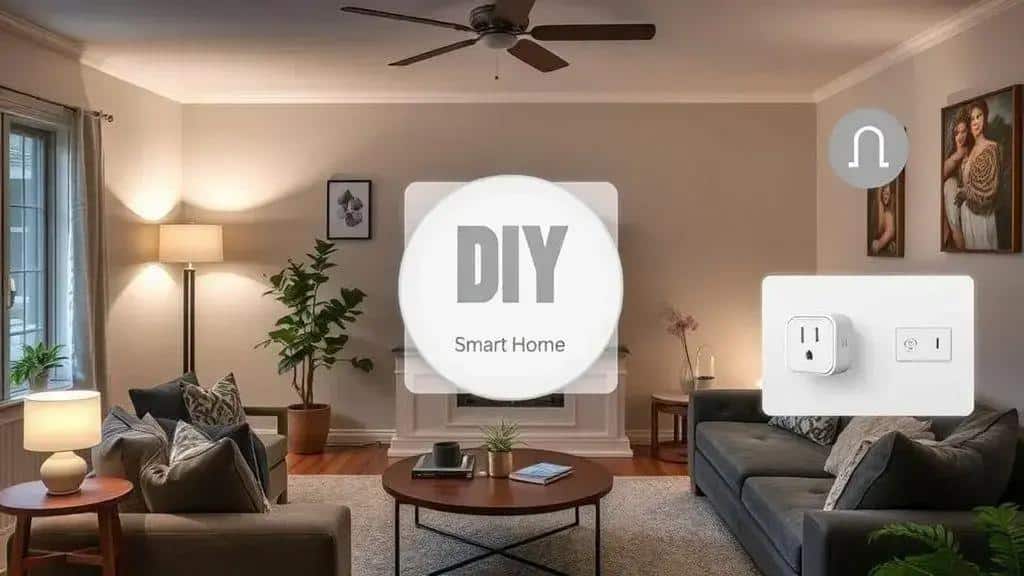
DIY tips for a smart home setup can make the process both fun and cost-effective. Setting up your own smart home allows you to customize everything to meet your needs. With just a few easy steps, you can create a smart environment without hiring a professional.
Choosing the Right Devices
Start by selecting devices that fit your lifestyle. Consider what areas of your home you want to upgrade first. Focus on devices that can work well together, like smart lighting and thermostats, for seamless integration.
- Smart bulbs: Begin with easy-to-install smart bulbs that fit standard light sockets.
- Smart plugs: Use smart plugs to control existing appliances and devices.
- Smart speakers: Choose a speaker that can act as your smart home hub, allowing voice control.
These basic devices can pave the way for a comprehensive smart home system.
Setting Up Your Smart Hub
Once you’ve chosen your devices, it’s essential to set up a smart hub. A hub connects all your devices, allowing them to communicate with each other. Using a central app on your smartphone can make controlling everything much simpler. Be sure to follow the installation instructions provided with each device carefully. This will ensure proper connectivity and functionality.
Creating Automation Routines
Automation routines can significantly enhance your smart home experience. Create schedules for devices to operate based on your daily routines. For example, you can program your lights to turn on at sunset or your thermostat to adjust when you leave the house.
- Time-based settings: Set routines based on the time of day.
- Location-based triggers: Use your smartphone’s GPS to trigger actions as you leave or arrive home.
- Scene settings: Create scenes that adjust multiple devices at once for activities like movie night.
Automating tasks not only saves energy but also adds convenience to your life.
Testing and Troubleshooting
Don’t forget to test your devices after installation. Ensure everything functions as planned and troubleshoot any issues that arise. Common problems might include connectivity issues or devices not responding as expected.
Referring to the user manuals can often help resolve problems quickly. You can also look for online forums or community groups where you can find solutions from other users.
Implementing these DIY tips for a smart home setup can enhance your living space while keeping expenses low. Creating a smart home tailored to your lifestyle is achievable and rewarding.
FAQ – Frequently Asked Questions about Building a Budget-Friendly Smart Home
What are the first steps to start building a budget-friendly smart home?
Begin by selecting a few key devices like smart bulbs and plugs that fit your lifestyle. Gradually expand as you learn more.
How can I automate my smart home devices?
Use apps associated with your devices to create routines. You can set schedules for lighting and temperature based on your daily habits.
What are some energy-saving benefits of smart home devices?
Smart devices can adjust settings automatically, reduce waste, and provide insights into your energy usage, saving you money on bills.
Is it difficult to set up a smart home myself?
Not at all! Many devices are designed for easy DIY installation, and there are plenty of resources available online to help guide you.

